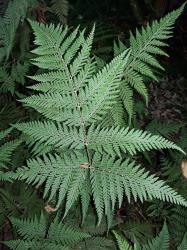Terrestrial (NZ) or rarely epiphytic ferns (not NZ). Rhizomes erect to long-creeping, scaly. Rhizome scales non-clathrate, linear to ovate, margins entire (NZ) or rarely toothed (not NZ), attached at base, concolorous, pale brown to almost black. Fronds monomorphic, occasionally bulbiferous (not NZ). Stipes and rachises scaly, hairy, adaxially sulcate. Laminae 3–4-pinnate (NZ), or 2– or 5-pinnate (not NZ), anadromous or catadromous, herbaceous, scaly, hairy and usually with unicellular glands. Hairs usually short and catenate. Veins free. Sori round, borne on abaxial surface, away from the margin, in 1 row either side of midrib; indusia reniform, peltate, or absent. Spores monolete; perispores rugose, tuberculate or echinate, sometimes minutely echinate on the surface.
A genus of c. 31 species (Gardner et al. 2017), included in the subfamily Elaphoglossoideae (PPG 1 2016).
Species of Parapolystichum were previously included in the genus Lastreopsis, which was revised by Tindale (1965). She recognised a total of 33 species, of which 17 occurred in Australia alone (Green 1994; Jones 1998). However, the genus has since been identified as paraphyletic, and subsequently split into two, with 18 species retained in a monophyletic Lastreopsis, 31 recognised in Parapolystichum, and four still incertae sedis (Labiak et al. 2014, 2015; Gardner et al. 2017). However, Labiak et al. (2014, 2015) were unable to find any morphological characters to distinguish Parapolystichum from Lastreopsis.
Allan (1961) initially treated Parapolystichum glabellum and P. microsorum subsp. pentagulare as Ctenitis glabella and C. decomposita, but, following Tindale (1957), he accepted both in Lastreopsis (Allan 1961, Supplementary Notes). New combinations in Parapolystichum were made by Labiak et al. (2015). Tindale (1965) noted an imperfectly known taxon from the Kermadec Islands, which was subsequently described as Lastreopsis kermadecensis by Perrie & Brownsey (2012), and transferred to Parapolystichum by Gardner et al. (2017).
| 1 | Rhizomes long-creeping, with fronds arising at intervals; fronds bearing whitish catenate hairs around the stipes and rachises, and on both lamina surfaces; abaxial rachis surface densely hairy | microsorum |
| Rhizomes erect or short-creeping, with fronds clustered at the apex; fronds bearing reddish catenate hairs, mainly along the adaxial groove of the rachis, and on the adaxial surfaces; abaxial rachis surface sparsely hairy or glabrous | 2 | |
| 2 | Secondary pinnae narrow, 10–90 mm long, 3–35 mm wide; hairs on adaxial costae up to 0.7 mm long; plants of main islands of New Zealand | glabellum |
| Secondary pinnae wider, 35–150 mm long, 11–45 mm wide; hairs on adaxial costae up to 0.3 mm long; plants confined to Kermadec Islands | kermadecense |
Currently no morphological characters are known that consistently distinguish Parapolystichum from Lastreopsis, and the two genera cannot always be recognised as such in the field.
In the Australasian region, species of Parapolystichum generally have erect to long-creeping rhizomes, laminae that are 2–4-pinnate and anadromous in the distal half, and sori that may be indusiate or exindusiate. They have short, catenate (ctenitoid) hairs on the lamina and rachis surfaces, rather than long, acicular or clavate hairs. By contrast, species of Lastreopsis subg. Lastreopsis generally have short- to long-creeping rhizomes (although not in L. velutina), laminae that are 3–5‑pinnate and catadromous in the distal half, and sori that are more frequently indusiate. They generally have long, acicular or clavate hairs on the lamina and rachis surfaces.
Parapolystichum extends from the Neotropics to Africa, Madagascar, Indonesia, Papua New Guinea, Australia, New Zealand and the south Pacific, with the centre of diversity in Australia; five species in the Neotropics, six in Africa, nine in Madagascar, one in Indonesia, one in Papua New Guinea, nine in Australia, one in New Caledonia and one in the Pacific (Tindale 1965; Labiak et al. 2014, 2015; Gardner et al. 2017). Three species in New Zealand; two endemic.
| Category | Number |
|---|---|
| Indigenous (Endemic) | 2 |
| Indigenous (Non-endemic) | 1 |
| Total | 3 |
The base chromosome number in Parapolystichum is x = 41 (Labiak et al. 2014).




